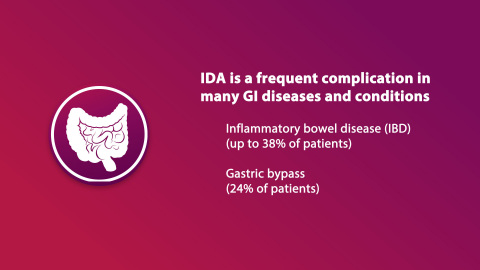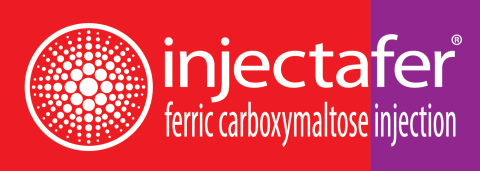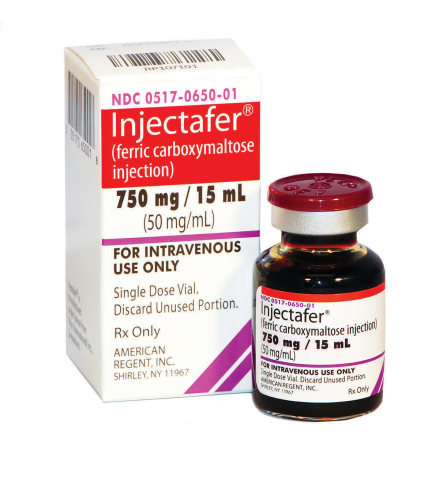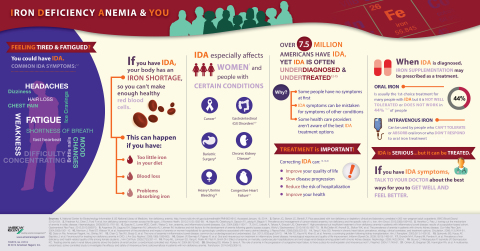CHICAGO--(BUSINESS WIRE)--American Regent, Inc., a subsidiary of Luitpold Pharmaceuticals, Inc. (a Daiichi Sankyo Group Company), announced today the presentation of new data at Digestive Disease Week 2014 in Chicago, IL, showing the efficacy and safety of high-dose injectable iron (Injectafer® [ferric carboxymaltose injection]) in patients with gastrointestinal-related iron deficiency anemia, as well as outlining the economic and medical resource use burden of iron deficiency anemia among inflammatory bowel disease and bariatric surgery patients in the United States. The three posters and key findings presented at the conference last week were:
-
Ferric Carboxymaltose: Efficacy and Safety in Patients with
Gastrointestinal-Related Iron Deficiency Anemia: A Pooled Analysis
Injectafer® (ferric carboxymaltose injection) is effective in patients with gastrointestinal-related iron deficiency anemia and has an improved safety profile compared to other IV irons, such as Venofer® (iron sucrose injection, USP). -
Economic and Medical Resource Use Burden of Iron Deficiency
Anemia in an Inflammatory Bowel Disease (IBD) Population in the United
States
IBD patients who develop iron deficiency anemia may have higher medical resource use and direct medical costs compared to those who do not develop this condition. Although most IBD patients who develop iron deficiency anemia are tested for their iron, most are not treated with oral or intravenous iron, and do not receive blood transfusions within the first year of developing iron deficiency anemia.
-
Economic and Medical Resource Use Burden of Iron Deficiency
Anemia in a Bariatric Surgery Population in the United States
Bariatric surgery patients who develop iron deficiency anemia may have higher complication rates, medical resource use, and direct medical costs compared to those who don’t develop iron deficiency anemia. Although most bariatric surgery patients who develop iron deficiency anemia are tested for their iron, most are not treated with oral or intravenous iron and do not receive blood transfusions in the first two years after surgery.
“The treatment of iron deficiency anemia is an important, unmet medical need. Gastrointestinal conditions that are associated with iron deficiency anemia include chronic inflammatory bowel diseases such as Crohn’s disease and ulcerative colitis. In addition, iron deficiency anemia can be associated with certain surgical procedures, such as bariatric surgery,” said blood disease expert Dr. Lawrence Goodnough, Director of Transfusion and Professor of Pathology and of Medicine at Stanford University Medical Center, who speaks more on the topic of iron deficiency anemia and gastrointestinal conditions in this short video. “These patients need help to meet their minimum daily iron needs.”
All three studies presented at the conference were sponsored by Luitpold Pharmaceuticals. Full abstracts can currently be found on the Digestive Disease Week website at http://www.ddw.org/program/abstracts.
“We are pleased to help support this research and raise awareness of the impact that iron deficiency anemia can have on gastrointestinal patients,” commented Jacalyn Beltrani, MBA, Vice President of Commercial Operations of American Regent.
About Iron Deficiency Anemia
There are over 7.5 million people in the US with iron deficiency anemia (IDA), a condition that occurs when body iron stores are inadequate for normal red blood cell production. Fatigue, difficulty concentrating, shortness of breath, and dizziness are common symptoms, significantly impacting patients’ quality of life. IDA is a common complication of many diseases and conditions, including cancer, chronic kidney disease, gastrointestinal conditions, obstetric and gynecological conditions and congestive heart failure. It affects up to one-third of inflammatory bowel disease patients and nearly one-quarter of patients who have undergone gastric bypass surgery. IDA is prevalent in women, affecting over 3 million US women of childbearing age due to conditions such as heavy uterine bleeding, postpartum anemia, and pregnancy. Blood disease expert Lawrence Goodnough, MD, from Stanford University Medical Center and Lynell D’Sylva, RN, BSN, from American Regent recently discussed the importance of maintaining sufficient iron levels on Lifetime’s special, The Balancing Act. The full segment can be viewed here.
About Injectafer®
Injectafer® (ferric carboxymaltose injection) is the first non-dextran intravenous (IV) iron approved for the treatment of adult patients with iron deficiency anemia of various etiologies who are intolerant to or who have had an unsatisfactory response to oral iron, in addition to use in adult non-dialysis dependent chronic kidney disease (CKD) patients. A single dose of up to 750 mg of Injectafer® can be administered undiluted as an IV push injection at a rate of 100 mg/minute or as an IV infusion in up to 250 mL 0.9 % sodium chloride injection, USP, over at least 15 minutes. Injectafer® is reimbursable using Q code 9970 for product-specific reimbursement, C code C9441 (Medicare-only hospital outpatient settings), and J code J3490 (delivery in physician offices and non-Medicare outpatient settings). The full prescribing information for Injectafer® is available at: http://www.injectafer.com/files/Prescribing_Information.pdf.
The safety and efficacy of Injectafer® for treatment of iron deficiency anemia was evaluated in two clinical trials (Trial 1 and Trial 2) in which Injectafer® was administered at a dose of 15 mg/kg body weight up to a maximum single dose of 750 mg of iron on two occasions separated by at least 7 days up to a maximum cumulative dose of 1500 mg of iron. The inclusion / exclusion criteria for both studies allowed patients with various comorbidities, characteristic of this broad patient population. Additionally, patients with a history of drug allergies were included in the trials, providing robust safety data in this difficult-to-treat subset of patients.
Trial 1 compared two 750-mg doses of Injectafer® to either oral or IV iron (standard of care therapy) in patients with iron deficiency anemia of various etiologies and included approximately 1000 patients, half of whom received Injectafer®. In this trial, Injectafer® raised hemoglobin more than oral iron or IV standard of care therapy, with a mean change in hemoglobin of 1.57 g/dL vs. 0.80 g/dL when compared to oral iron and 2.90 g/dL vs. 2.16 g/dL when compared with IV standard of care therapy. These increases were statistically significant (p=0.001). In addition, a significantly higher proportion of patients who received Injectafer® achieved a hemoglobin of >12 g/dL during the course of treatment compared to both oral iron (57.0% vs. 29.1%, respectively) and IV standard of care (50.6% vs. 24.5%, respectively) (p=0.001 for both). Further, cardiovascular safety was evaluated based on an adjudicated composite safety endpoint comprised of death, myocardial infarction, stroke, unstable angina, congestive heart failure, arrhythmias, hypertension and hypotension. Rates of the composite safety endpoint were 3.95% for Injectafer® vs. 4.90% when compared to IV standard of care and 2.85% for Injectafer® vs. 1.58% when compared to oral iron.
Trial 2, the largest head-to-head study of IV iron in high-risk patients with iron deficiency anemia and CKD, compared Injectafer® to Venofer® (iron sucrose injection, USP; American Regent, Inc., Shirley, NY) and included 2561 patients, approximately half of whom received Injectafer®. In these high-risk patients, two 750-mg doses of Injectafer® increased hemoglobin more than five 200-mg doses of Venofer®, with a change in hemoglobin of 1.13 g/dL for Injectafer® vs. 0.92 for Venofer®. These increases were statistically significant (treatment difference [95% CI] = 0.21 [0.13 to 0.28]). Rates of the adjudicated composite safety endpoint comprised of death, myocardial infarction, stroke, unstable angina, congestive heart failure, arrhythmias, hypertension and hypotension were statistically similar at 13.71% for Injectafer® vs. 12.14% for Venofer® (treatment difference [95% CI] = 1.57% [- 1.10% to 4.25%]). Rates of a composite of death, myocardial infarction and stroke were 1.88% for Injectafer® vs. 2.72% for Venofer®.
Injectafer® is manufactured and marketed under the name of Ferinject® (ferric carboxymaltose injection) by Vifor Pharma (Switzerland) outside of North America.
IMPORTANT SAFETY INFORMATION
INDICATIONS/CONTRAINDICATIONS
Injectafer® (ferric carboxymaltose injection) is an iron replacement product indicated for the treatment of iron deficiency anemia in adult patients who have intolerance to oral iron or have had unsatisfactory response to oral iron, and in adult patients with non-dialysis dependent chronic kidney disease. Injectafer® is contraindicated in patients with hypersensitivity to Injectafer® or any of its inactive components.
WARNINGS AND PRECAUTIONS
Serious hypersensitivity reactions, including anaphylactic-type reactions, some of which have been life-threatening and fatal, have been reported in patients receiving Injectafer®. Patients may present with shock, clinically significant hypotension, loss of consciousness, and/or collapse. Monitor patients for signs and symptoms of hypersensitivity during and after Injectafer® administration for at least 30 minutes and until clinically stable following completion of the infusion. Only administer Injectafer® when personnel and therapies are immediately available for the treatment of serious hypersensitivity reactions. In clinical trials, serious, anaphylactic/anaphylactoid reactions were reported in 0.1% (2/1775) of subjects receiving Injectafer®. Other serious or severe adverse reactions potentially associated with hypersensitivity which included, but were not limited to, pruritus, rash, urticaria, wheezing, or hypotension were reported in 1.5% (26/1775) of these subjects.
In clinical studies, hypertension was reported in 3.8% (67/1775) of subjects. Transient elevations in systolic blood pressure, sometimes occurring with facial flushing, dizziness, or nausea were observed in 6% (106/1775) of subjects. These elevations generally occurred immediately after dosing and resolved within 30 minutes. Monitor patients for signs and symptoms of hypertension following each Injectafer® administration. In the 24 hours following administration of Injectafer®, laboratory assays may overestimate serum iron and transferrin bound iron by also measuring the iron in Injectafer®.
ADVERSE REACTIONS
In two randomized clinical studies, a total of 1775 patients were exposed to Injectafer®, 15/mg/kg of body weight, up to a single maximum dose of 750 mg of iron on two occasions, separated by at least 7 days, up to a cumulative dose of 1500 mg of iron. Adverse reactions reported by ≥ 2% of Injectafer®-treated patients were nausea (7.2%); hypertension (3.8%); flushing/hot flush (3.6%); blood phosphorus decrease (2.1%); and dizziness (2.0%).
The following serious adverse reactions have been most commonly reported from the post-marketing spontaneous reports: urticaria, dyspnea, pruritus, tachycardia, erythema, pyrexia, chest discomfort, chills, angioedema, back pain, arthralgia and syncope.
See full prescribing information at www.injectafer.com.
About American Regent
American Regent Inc., a wholly owned subsidiary of Luitpold Pharmaceuticals, Inc. (a Daiichi Sankyo Group Company), headquartered in Shirley, NY, distributes over 80 pharmaceutical products, including Venofer® (iron sucrose injection, USP), the #1 selling intravenous Iron therapy in the United States, and Injectafer® (ferric carboxymaltose injection), the first and only high-dose intravenous iron for iron deficiency anemia of various etiologies in adult patients intolerant to oral iron or who have had an unsatisfactory response to oral iron, in addition to use in adult non-dialysis dependent chronic kidney disease patients. For more information, please visit www.americanregent.com.
About Luitpold Pharmaceuticals, Inc.
Luitpold Pharmaceuticals, Inc., a Daiichi Sankyo Group Company headquartered in Shirley, NY, manufactures over 80 pharmaceutical products, including Venofer® (iron sucrose injection, USP), the # 1 selling intravenous iron therapy in the US, and Injectafer® (ferric carboxymaltose injection), the first and only high-dose intravenous iron for iron deficiency anemia of various etiologies in adult patients intolerant to oral iron or who have had an unsatisfactory response to oral iron, in addition to use in adult non-dialysis dependent chronic kidney disease patients, which are distributed through its human health subsidiary, American Regent, Inc. Luitpold Pharmaceuticals, also markets dental bone regeneration products and veterinary pharmaceuticals through its Osteohealth and Animal Health divisions, respectively. For more information on Luitpold or any of its divisions, please visit: www.luitpold.com.
About Daiichi Sankyo
The Daiichi Sankyo Group is dedicated to the creation and supply of innovative pharmaceutical products to address the diversified, unmet medical needs of patients in both mature and emerging markets. While maintaining its portfolio of marketed pharmaceuticals for hypertension, hyperlipidemia, and bacterial infections, the Group in engaged in the development of treatments for thrombotic disorders and focused on the discovery of novel oncology and cardiovascular-metabolic therapies. Furthermore, the Daiichi Sankyo Group has created a “Hybrid Business Model”, which will respond to market and customer diversity and optimize growth opportunities across the value chain. For more information, please visit: www.daiichisankyo.com.
About Vifor Pharma
Vifor Pharma, a company of the Galenica Group, is a world leader in the discovery, development, manufacturing and marketing of pharmaceutical products for the treatment of iron deficiency. The company also offers a diversified portfolio of prescription medicines as well as over-the-counter (OTC) products. Vifor Pharma, headquartered in Zurich, Switzerland, has an increasingly global presence and a broad network of affiliates and partners around the world. For more information about Vifor Pharma and its parent company Galenica, please visit www.viforpharma.com and www.galenica.com.
Venofer® (iron sucrose injection, USP) and Injectafer® (ferric carboxymaltose injection) are manufactured under license from and are registered trademarks of Vifor (International) Inc., Switzerland.
This press release has an accompanying Smart Marketing Page providing further details about the organization, products and services introduced above. You can access the Smart Marketing Page via the following link: http://smp.businesswire.com/pages/american-regent-highlights-challenges-treatment-options-GI-related-iron-deficiency-anemia.








